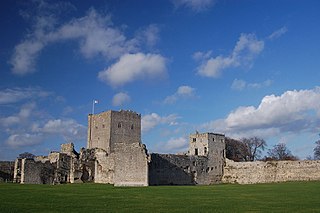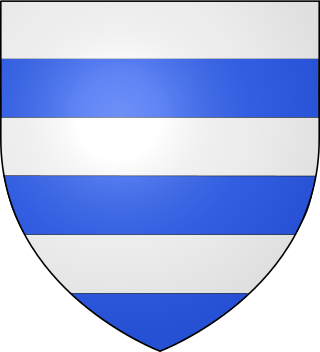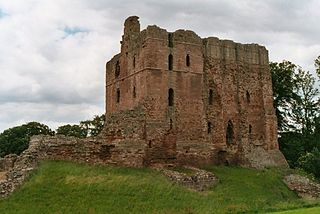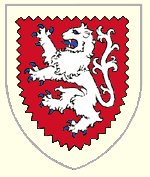The Grey family


The Grey family of Heaton was descended from Hugh de Grey, a younger son of Henry de Grey (1155-1219) of Grays Thurrock in Essex, a courtier of King John, whose ancestry is traceable back to Anchetil de Greye (c.1052 - post-1086), a Norman soldier and follower of William FitzOsbern, 1st Earl of Hereford one of the great magnates of early Norman England and one of the very few proven companions of William the Conqueror known to have fought at the Battle of Hastings in 1066. The descent of the de Grey family of Heaton is as follows:
- Sir Thomas Grey (d.1344), 3rd in descent from Hugh de Grey, was an eminent soldier in the Anglo-Scottish wars in the reigns of Edward I and Edward II. He married Agnes de Bayles.
- Sir Thomas Grey (d.1369), son, "The Chronicler", who wrote the English chronicle, the Scalacronica . He married Margaret de Presson, [5] the daughter and heiress of William de Presson [6] of Presson, near Carham in Northumberland.
- Sir Thomas Grey (1359-1400) of Heaton and of Chillingham Castle, who married Joan de Mowbray (d.1410), sister of Thomas de Mowbray, 1st Duke of Norfolk, [7] and daughter of John de Mowbray, 4th Baron Mowbray (d.1368) by his wife and Elizabeth de Segrave, daughter and heiress of John de Segrave, 4th Baron Segrave by his wife Margaret of Brotherton (c.1320-1399), suo jure 'Countess of Norfolk, in 1397 created Duchess of Norfolk for life, the daughter and eventual sole heiress of Thomas of Brotherton, eldest son of King Edward I of England, by his second marriage. In 1338 she succeeded to the Earldom of Norfolk and the office of Earl Marshal. His second son was John Grey, 1st Earl of Tankerville [8] [9] (1384-1421), KG.
- Sir Thomas Grey (1384-1415), son, one of the three conspirators in the Southampton Plot against King Henry V in 1415. In about 1408 he married Alice Neville, a daughter of Ralph Neville, 1st Earl of Westmorland, by his first wife Margaret de Stafford (d.1396), a daughter of Hugh de Stafford, 2nd Earl of Stafford.
- Sir Thomas Grey (1404-1426), who in 1412, at eight years of age, was betrothed to Isabel, then three years of age, only daughter of Richard of Conisburgh, 3rd Earl of Cambridge, [10] and Anne Mortimer; they had one son. [11] At about this time the family abandoned Heaton and moved to its other estate at Howick in Northumberland. His descendants gained peerage titles including: Baronet Grey of Chillingham, Northumberland (1619); Baron Grey of Werke (1623/4); Baronet Grey of Howick (1746); Baron Grey of Howick (1801); Viscount Howick (1806); Earl Gret (1806). His most notable descendant was Charles Grey, 2nd Earl Grey, 2nd Viscount Howick (1764-1845), KG, of Howick Hall, Prime Minister and supposed inventor of the famous tea.
History of the broader de Grey family
The de Grey family was descended from Anchetil de Greye (c.1052 - post-1086), a Norman soldier and follower of William FitzOsbern, 1st Earl of Hereford, one of the great magnates of early Norman England and one of the very few proven companions of William the Conqueror known to have fought at the Battle of Hastings in 1066. Anchetil de Greye is regarded as the ancestor of the noble House of Grey, branches of which held many peerage titles in England, including Baron Grey de Wilton, Baron Grey of Codnor, Baron Grey de Ruthyn, Marquess of Dorset, Duke of Suffolk, and Earl of Stamford. They[ clarification needed ] married into the royal family.
Descendants of the branch seated at Heaton gained the peerage titles of: Earl of Tankerville (1419, 1695), Baronet Grey of Chillingham, Northumberland (1619); Baron Grey of Werke (1623/4); Viscount Glendale (1695), Baronet Grey of Howick (1746); Baron Grey of Howick (1801); Viscount Howick (1806), Earl Grey (1806) and Baronet Grey of Fallodon (1814). Charles Grey, 2nd Earl Grey, 2nd Viscount Howick (1764-1845), KG, of Howick Hall, Prime Minister, and supposed inventor of the famous tea, was a descendant of the Heaton branch.













